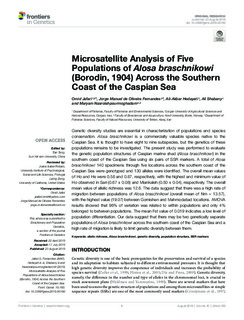| dc.contributor.author | Jafari, Omid | |
| dc.contributor.author | Fernandes, Jorge Manuel de Oliveira | |
| dc.contributor.author | Hedayati, Ali-Akbar | |
| dc.contributor.author | Shabany, Ali | |
| dc.contributor.author | Nasrolahpourmoghadam, Maryam | |
| dc.date.accessioned | 2019-11-26T10:57:39Z | |
| dc.date.available | 2019-11-26T10:57:39Z | |
| dc.date.created | 2019-10-29T12:03:25Z | |
| dc.date.issued | 2019 | |
| dc.identifier.citation | Jafari, O., Fernandes, J. M. d. O., Hedayati, A.-A., Shabany, A. & Nasrolahpourmoghadam, M. (2019). Microsatellite analysis of five populations of Alosa braschnikowi (Borodin, 1904) across the Southern coast of the Caspian Sea. Frontiers in Genetics, 10: 760. doi: | nb_NO |
| dc.identifier.issn | 1664-8021 | |
| dc.identifier.uri | http://hdl.handle.net/11250/2630471 | |
| dc.description.abstract | Genetic diversity studies are essential in characterization of populations and species conservation. Alosa braschnikowi is a commercially valuable species native to the Caspian Sea. It is thought to have eight to nine subspecies, but the genetics of these populations remains to be investigated. The present study was performed to evaluate the genetic population structures of Caspian marine shad (Alosa braschnikowi) in the southern coast of the Caspian Sea using six pairs of SSR markers. A total of Alosa braschnikowi 140 specimens through five locations across the southern coast of the Caspian Sea were genotyped and 130 alleles were identified. The overall mean values of Ho and He were 0.58 and 0.87, respectively, with the highest and minimum value of Ho observed in Sari (0.67 ± 0.08) and Miankaleh (0.50 ± 0.04), respectively. The overall mean value of allelic richness was 12.6. The data suggest that there was a high rate of migration between populations of Alosa braschnikowi (overall mean of Nm = 13.57), with the highest value (19.07) between Gomishan and Mahmodabad locations. AMOVA results showed that 96% of variation was related to within populations and only 4% belonged to between populations. The mean Fst value of 0.019 indicates a low level of population differentiation. Our data suggest that there may be two genetically separate populations of Alosa braschnikowi across the southern coast of the Caspian Sea and a high rate of migration is likely to limit genetic diversity between them. | nb_NO |
| dc.description.abstract | Microsatellite Analysis of Five Populations of Alosa braschnikowi (Borodin, 1904) Across the Southern Coast of the Caspian Sea | nb_NO |
| dc.language.iso | eng | nb_NO |
| dc.publisher | Frontiers Media S.A. | nb_NO |
| dc.rights | Navngivelse 4.0 Internasjonal | * |
| dc.rights.uri | http://creativecommons.org/licenses/by/4.0/deed.no | * |
| dc.title | Microsatellite analysis of five populations of Alosa braschnikowi (Borodin, 1904) across the Southern coast of the Caspian Sea | nb_NO |
| dc.type | Journal article | nb_NO |
| dc.type | Peer reviewed | nb_NO |
| dc.description.version | publishedVersion | nb_NO |
| dc.rights.holder | © 2019 The Author(s) | nb_NO |
| dc.subject.nsi | VDP::Matematikk og Naturvitenskap: 400::Basale biofag: 470::Genetikk og genomikk: 474 | nb_NO |
| dc.source.pagenumber | 8 | nb_NO |
| dc.source.volume | 10 | nb_NO |
| dc.source.journal | Frontiers in Genetics | nb_NO |
| dc.identifier.doi | 10.3389/fgene.2019.00760 | |
| dc.identifier.cristin | 1741634 | |

